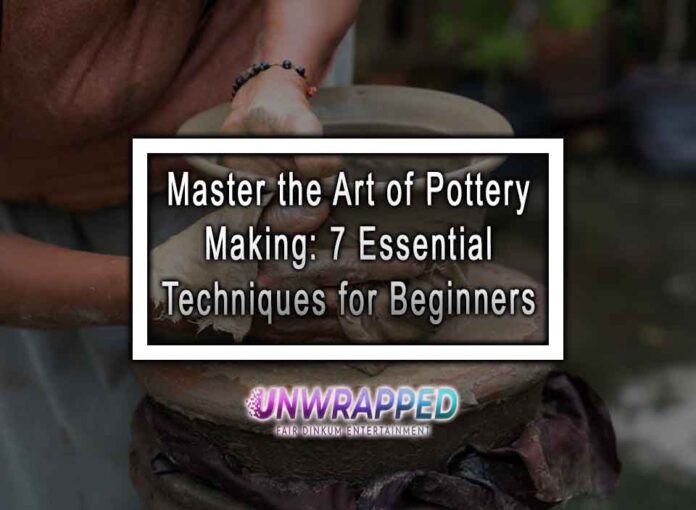Unleash Your Creativity with Pottery Making!
If you’ve ever marveled at the beauty of handmade pottery and wondered how those exquisite pieces are created, look no further! In this listicle, we’ll delve into the art of pottery making and unveil seven essential techniques that will help you embark on your own pottery journey. Whether you’re a beginner or simply curious about this ancient craft, prepare to get your hands dirty and unlock your inner artist!
1. Hand-Building: From Clay to Creation
Hand-building is one of the oldest and most versatile pottery techniques. It allows you to mold clay into various shapes using your hands and a few simple tools. Pinch pots, made by forming clay between your fingers, are a great starting point. Coiling involves rolling clay into long ropes and stacking them to create vessels, while slabs are flat pieces of clay that can be shaped into plates or tiles. Explore the tactile nature of hand-building and experiment with different textures and forms.
2. Throwing on the Wheel: Mastering the Spinning Art
The potter’s wheel is a mesmerizing tool that allows you to shape clay with precision and finesse. Wheel-throwing requires practice and patience, but it’s a rewarding technique once mastered. Begin by learning how to center the clay on the wheel, a crucial step that ensures stability and balance. Then, practice pulling and shaping the clay to create symmetrical bowls, cups, and vases. With time, you’ll develop a sense of rhythm and control that will elevate your pottery skills.
3. Glazing: Adding Vibrancy and Texture
Unleash the magic of glazes! Glazes are liquid coatings applied to pottery before firing. They offer a wide range of colors and textures, transforming plain clay surfaces into vibrant and captivating pieces of art. Explore different glaze application methods, such as dipping, brushing, and spraying. Experiment with layering glazes to create unique effects like speckling, dripping, and marbling. The possibilities are endless, allowing you to express your creativity and enhance the visual appeal of your pottery.
4. Carving and Incising: Unleash Your Inner Sculptor
Take your pottery to the next level by incorporating carving and incising techniques. Carving involves removing clay from the surface to create decorative patterns, while incising entails making shallow cuts or lines. These techniques allow you to add intricate details and textures to your pottery. From delicate floral motifs to bold geometric patterns, let your imagination run wild and transform your pieces into unique works of sculptural beauty.
5. Decorating with Slip: A Splash of Color and Detail
Slip, a liquid clay mixture, offers a versatile medium for adding color, texture, and detail to your pottery. Create your own slip by mixing clay with water to the desired consistency. Utilize slip trailing, a technique where slip is poured into a fine-tip bottle and used to draw lines and create patterns on the clay surface. Explore slip painting, which involves applying slip with a brush, and slip inlay, where carved designs are filled with colored slip. Let slip be your artistic paintbrush, infusing your pottery with captivating hues and intricate designs.
6. Firing: The Transformational Journey
Understanding the firing process is crucial to achieving durable and functional pottery. Pottery undergoes a transformative journey during firing, where clay hardens and glazes melt to form a glass-like surface. Explore the basics of kiln operation, temperature control, and different firing methods. Bisque firing, the initial firing at a lower temperature, prepares the pottery for glazing. Glaze firing follows, reaching higher temperatures to melt the glazes and create the final finish. Learn about the unique transformations that occur during firing and gain insight into the technical aspects of pottery making.
7. Finishing Touches: From Sanding to Polishing
Once your pottery is fired and cooled, it’s time for the final touches. Sanding and polishing are essential steps to achieve a smooth and flawless finish. Use sandpaper or specialized pottery tools to refine the surface of your pieces, ensuring there are no rough edges or imperfections. Pay attention to small details and add final embellishments, such as decorative handles or carved accents. These finishing touches demonstrate your dedication to craftsmanship and elevate the overall quality of your pottery.
Unleash Your Inner Potter and Create Timeless Treasures!
Now that you’ve discovered the art of pottery making, it’s time to dive in and let your creativity soar. Whether you prefer the versatility of hand-building, the finesse of wheel-throwing, or the exploration of decorative techniques, pottery offers endless possibilities for artistic expression. Embrace the joy of molding clay with your hands, experiment with glazes and textures, and embark on a journey that combines artistry and craftsmanship. Start your pottery adventure today and discover the timeless satisfaction of creating unique, handcrafted treasures!
Must-read: Unveiling the Magic: Folklore and Storytelling in Festivals










